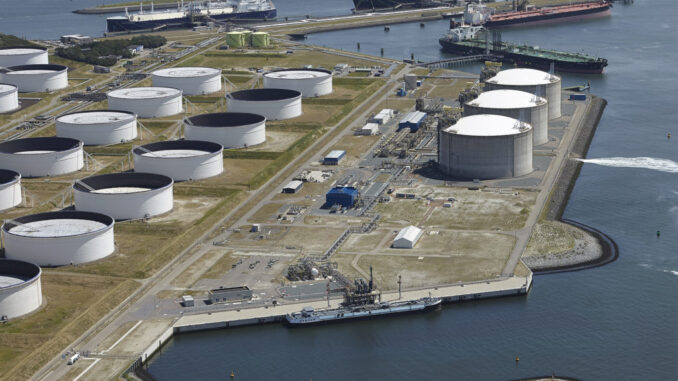
Downstream in the oil and gas industry is the final stage of the production process, where crude oil and natural gas are processed, refined and distributed to consumers. The downstream component of the oil and gas industry includes activities such as refining, storage, transportation, and marketing of petroleum products, as well as the sale of petrochemicals and related products. Downstream operations are the key to the profitability of the industry, as they involve the most direct interaction with customers and the greatest potential for profits.
In this article, we will explore the importance of downstream operations in the oil and gas industry, its various components and processes, and the challenges it faces. We will also provide examples of successful downstream operations and their impact on the industry.
Definition of Downstream
Downstream operations in the oil and gas industry refer to the activities after the production stage, such as refining, storage, transportation, and marketing of petroleum products. Downstream operations involve the conversion of raw materials into products that can be consumed by end users. The downstream component of the industry involves a complex web of processes and activities, from the extraction of crude oil and gas from the ground to its delivery to consumers.
Importance of Downstream
Downstream operations are essential for the oil and gas industry, as they are responsible for the final stage of production and the most direct interaction with customers. This component of the industry is the key to its profitability, as it is where the greatest potential for profits lies. Downstream operations also provide a reliable source of energy to consumers and help increase energy security.
Components of Downstream
Downstream operations in the oil and gas industry involve a complex web of processes and activities. These include refining, storage, transportation, and marketing of petroleum products, as well as the sale of petrochemicals and related products.
Refining is the process of converting raw materials into products that can be consumed by end users. This usually involves distillation, cracking, and other processes that separate and convert the components of crude oil and natural gas into useful products.
Storage involves the storing of petroleum products in tanks and other facilities until they are ready for distribution. This helps ensure that there is a consistent supply of products to meet customer demand.
Transportation involves the movement of petroleum products from the storage facilities to the customer. This is done by ships, pipelines, and trucks, depending on the product and the distance involved.
Marketing involves the promotion of petroleum products to potential customers. This usually involves advertising, public relations, and other activities aimed at increasing awareness and demand for the products.
Petrochemicals are the products derived from crude oil and natural gas that are used in a wide range of applications, from plastics and fertilizers to fuel additives and lubricants. Petrochemicals are also used in the production of pharmaceuticals, cosmetics, and other consumer products.
Challenges Faced by Downstream
The downstream component of the oil and gas industry is facing a number of challenges, from increasing competition to rising costs and changing customer demands. There is also a need for more efficient and sustainable operations, as well as improved safety standards.
Another challenge facing the industry is the need to manage the volatile price of crude oil, which can have a significant impact on the profitability of downstream operations. This is especially true for refining, where the cost of crude oil is a major factor in determining the final price of the products.
Examples of Successful Downstream Operations
There are a number of examples of successful downstream operations in the oil and gas industry. One such example is Saudi Aramco, the world’s largest oil producer, which has built a successful downstream business that accounts for nearly half of its total profits. The company has invested heavily in refining and petrochemicals and has become a major player in the global petrochemicals market.
Another example is ExxonMobil, the largest publicly traded oil and gas company in the world. ExxonMobil has a strong downstream business, which includes refining, marketing, and petrochemicals. The company is also investing in renewable energy, such as hydrogen and biofuels, to diversify its business and reduce its carbon footprint.
Conclusion
Downstream operations are essential for the profitability of the oil and gas industry, as they involve the most direct interaction with customers and the greatest potential for profits. This component of the industry includes activities such as refining, storage, transportation, and marketing of petroleum products, as well as the sale of petrochemicals and related products. However, the industry is facing a number of challenges, including increasing competition, rising costs, and changing customer demands. There are also a number of successful examples of downstream operations, such as those of Saudi Aramco and ExxonMobil.
Overall, downstream operations are a vital and essential component of the oil and gas industry. This component of the industry is the key to its profitability and provides a reliable source of energy to consumers.
References
Al-Khowaiter, F., & Al-Khowaiter, A. (2015). Downstream Operations in the Oil and Gas Industry: An Overview. The Oil & Gas Year.
ExxonMobil. (2020). Downstream. Retrieved from https://corporate.exxonmobil.com/en/energy/downstream
Hess, K. (2020). What is Downstream Oil and Gas? Retrieved from https://www.investopedia.com/articles/investing/062215/what-downstream-oil-and-gas.asp
International Energy Agency. (2020). Oil and Gas Downstream. Retrieved from https://www.iea.org/oilandgas/downstream/
Saudi Aramco. (2020). Downstream. Retrieved from https://www.saudiaramco.com/en/business-lines/downstream.html
Wang, J. (2020). What is Downstream in Oil & Gas Industry? Retrieved from https://www.cem-int.com/what-is-downstream-in-oil-gas-industry/
Submit your Article Ideas to The Crude Life! Email studio@thecrudelife.com
About The Crude Life
Award winning interviewer and broadcast journalist Jason Spiess and Content Correspondents engage with the industry’s best thinkers, writers, politicians, business leaders, scientists, entertainers, community leaders, cafe owners and other newsmakers in one-on-one interviews and round table discussions.
The Crude Life has been broadcasting on radio stations since 2012 and posts all updates and interviews on The Crude Life Social Media Network.
Everyday your story is being told by someone. Who is telling your story? Who are you telling your story to?
#thecrudelife promotes a culture of inclusion and respect through interviews, content creation, live events and partnerships that educate, enrich, and empower people to create a positive social environment for all, regardless of age, race, religion, sexual orientation, or physical or intellectual ability.
Sponsors, Music and Other Show Notes

Studio Sponsor: The Industrial Forest
The Industrial Forest is a network of environmentally minded and socially conscious businesses that are using industrial innovations to build a network of sustainable forests across the United States.
Weekly Sponsor: Stephen Heins, The Practical Environmentalist
Historically, Heins has been a writer on subjects ranging from broadband and the US electricity grid, to environmental, energy and regulatory topics.
Heins is also a vocal advocate of the Internet of Everything, free trade, and global issues affecting the third of our planet that still lives in abject poverty.
Heins is troubled by the Carbon Tax, Cap & Trade, Carbon Offsets and Carbon Credits, because he questions their efficacy in solving the climate problem, are too gamable by rent seekers, and are fraught with unreliable accounting.
Heins worries that climate and other environmental reporting in the US and Europe has become too politicized, ignores the essential role carbon-based energy continues to play in the lives of billions, demonizes the promise and practicality of Nuclear Energy and cheerleads for renewable energy sources that cannot solve the real world problems of scarcity and poverty.
Look at what’s happened to me.
I can’t believe it myself.
Suddenly I’m down at the bottom of the world.
It should have been somebody else
Believe it or not, I’m walking on air.
I never thought I could feel so free-e-e.
Barterin’ away with some wings at the fair
Who could it be?
Believe it or not it’s just me
The Last American Entrepreneur
Click here of The Last American Entrepreneur’s website

Studio Email and Inbox Sponsor: The CarbonPatchKids
The CarbonPatchKids are a Content Story Series targeted for Children of All Ages! In the world of the CarbonPatch, all life matters and has a purpose. Even the bugs, slugs, weeds and voles.
The CarbonPatchKids love adventures and playing together. This interaction often finds them encountering emotional experiences that can leave them confused, scared or even too excited to think clearly!
Often times, with the help of their companions, the CarbonPatchKids can reach a solution to their struggle. Sometimes the CarbonPatchKids have to reach down deep inside and believe in their own special gift in order to grow.
The caretakers of CarbonPatch do their best to plant seeds in each of the CarbonPatchKids so they can approach life’s problems with a non-aggressive, peaceful and neighborly solution.
CarbonPatchKids live, work and play in The Industrial Forest.
Click here for The CarbonPatchKids’ website

Featured Music: Alma Cook
Click here for Alma Cook’s music website
Click here for Alma Cook’s day job – Cook Compliance Solutions
For guest, band or show topic requests, email studio@thecrudelife.com
Spread the word. Support the industry. Share the energy.





